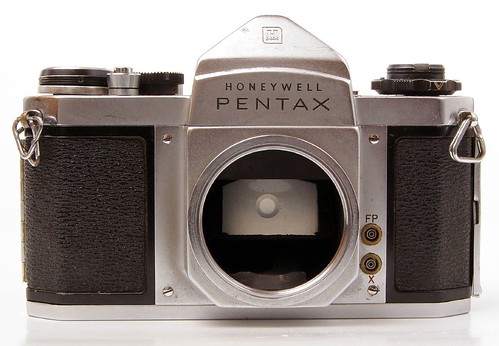The Asahi Pentax, to camera collectors, the AP, was a major progress in the 35mm SLR field of cameras when introduced in 1957. It is the first “modern” Japanese camera, combining a pleasing body design with easily handled controls. It is surprisingly similar to its predecessor, the Asahiflex, sharing the size and shape of the body casting, while just as similar to its successors right up to the last Spotmatic and beyond. The key feature is the pentaprism, greatly improving the viewfinder over the reversed image hard-to-follow waist-level finder, and its name reflects this fact. It is by no means the first SLR using the pentaprism, but it is certainly the first easily handled camera of its kind, sporting a fast operated wind lever, and rewind knob with a small foldable rewind crank handle.
Still rooted in early camera design, it lacks a few conveniences later taken for granted. The most obvious one being slow speed dial at the front, a manual preset lens, and a manual reset external frame counter, but apart from that nothing much sets it apart from cameras made close to two decades later. In models soon to follow, those features would be added one by one.
The Asahi Pentax S was launched the following year, in 1958. It has the standardised shutter speed sequence as the only significant improvement.
The Asahi Pentax K was introduced the same year at the 1958 Photokina in Cologne as the successor to the previous model. It has an automatic aperture stop down mechanism operating on a new range of lenses. These lenses must be manually cocked to stay open, and to stop down automatically. They have a chrome knob on the side. A moving plate at the base inside the camera lensmount pushes a pin protruding from the back of the lens to close the lens. The shutter top speed was increased to 1/1000 second.
The Asahi Pentax S2 / H2 came out in the autumn of 1959, and so was the slow speed dial at the camera front gone, all speeds was now on a stationary dial. The camera was available in chrome or black finish. Among the improvements is a Fresnel focusing screen with a central micro-prism spot, but the 1/1000 sec top speed was gone. The US distributor was now the Heiland division of the Honeywell Corporation, and the model accordingly engraved H2 on the top plate, and soon the Asahi name was replaced by Heiland on the prism housing. A tiny indicator window next to the shutter release showing red when the camera is wound was introduced with this model, a feature that is found on every model including the 1975 series KM, KX and K1000, but is left out on K2.
The Asahi Pentax S3 / H3 was presented at the 1960 Photokina. It feature again the 1/1000 sec top shutter speed and a faster Auto-Takumar1: 1.8 / 55mm standard lens. During its production run, the clip on Asahi Pentax Meter became available, requiring a notch in the shutter-speed dial to engage. Its scale indicates directly the aperture value to be set at the lens.
The Asahi Pentax S1 / H1 was launched in 1961 as a compliment to the previous model. The fastest speed indicted on the shutter-peed dial is 500, while still working at 1/1000 sec. It was removed for marketing reasons, as was the faster 1:1.8 lens. It was replaced by the slower 1:2 aperture standard lens, permitting a lower sales price to meet the competition, while the provision for the exposure meter was retained.
The Asahi Pentax SV / H3v was introduced in 1963. This introduces the fully automatic aperture operation on the Asahi Pentax cameras. For the US market, this model was regarded as a replacement for the H3 with the addition of a self-timer (v), which was the other new thing on this model. It is situated under the rewind knob with an integral film reminder dial. A curved arrow and a chrome release button on the top plate next to it complement the function. A yellow engraved V on the dial indicates when the picture will be taken as seen from the camera front. A new automatic resetting frame counter is placed under a cover on top of the wind-lever hub. The standard lens is the Super-Takumar 1:1.8 / 55mm.
The Asahi Pentax S1a / H1a was introduced as the economy model of the SV, at a 20% discount. It lacked the self-timer and came with the Super-Takumar 1:2 / 55mm lens. As on the S1, it also has a hidden 1/1000 sec shutter speed, and the lens is optically not different from the 1:1.8 version.
This concludes the so-called S-family of Pentax cameras, followed in 1964 by the Spotmatic family. These S-cameras are sturdy and dependable still after half a century if cared for, and are just as capable now as they were back then. It is always a joy to pick up one and know the shutter still fires correctly.
